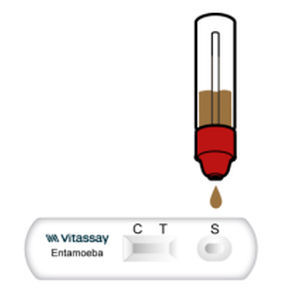
- Laboratory
- Laboratory medicine
- Rapid infectious disease test
- VITASSAY HEALTHCARE S.L.
Entamoeba rapid test for infectious diseasesfor antigensstool
Add to favorites
Compare this product
Characteristics
- Applications
- for infectious diseases
- Tested parameter
- for antigens
- Micro-organism
- Entamoeba
- Sample type
- stool, cell
- Analysis mode
- immunochromatographic
- Result display time
10 min
- Specificity
99 %
- Sensitivity
73 %
Description
Vitassay Entamoeba is a rapid, immunochromatographic, one step assay for the qualitative detection of Entamoeba histolytica and Entamoeba dispar in human stool samples. Simple, non-invasive and highly sensitivity screening assay to make a presumptive diagnosis of Entamoeba infection (amoebiasis).
INTRODUCTION
Entamoeba histolytica is a protozoan parasite that invades through the intestinal epithelium via a unique cell biologic process called trogocytosis, resulting in diarrhea, dysentery, and extra intestinal disease. The genus Entamoeba contains many species, six of which are found in the human intestinal tract: Entamoeba histolytica, Entamoeba dispar, Entamoeba moshkovskii, Entamoeba coli, Entamoeba hartmanni, and Entamoeba polecki. Of these species, only E. histolytica is associated with pathological injuries; the others are considered to be nonpathogenic species. Food and drink contaminated with faeces containing the cysts is a common source of infection. Most cases arise from human carriers, or cyst passers, who pass cysts in formed or semiformed stools. Because transmission is frequently associated with contaminated food and water, young infants are not expected to develop amebiasis very often. More severe disease is associated with young age, malnutrition and immunosuppression.
The motil (trophozoite) form of E. histolytica inhabits the human colon where it multiplies and differentiates into cysts that are released into the environment. In turn, these cysts are responsible for transmitting the infection to another host via the fecal-oral route.
Catalogs
No catalogs are available for this product.
See all of VITASSAY HEALTHCARE S.L.‘s catalogsRelated Searches
- Assay kit
- Solution reagent kit
- Blood assay kit
- Molecular biology reagent kit
- Plasma assay kit
- Infectious disease detection kit
- Blood rapid diagnostic test
- Diagnostic reagent kit
- Rapid lateral flow test
- Enzyme reagent kit
- Immunoassay rapid diagnostic test
- Molecular test kit
- Cassette rapid diagnostic test
- Virus rapid diagnostic test
- Respiratory infection test kit
- Optical assay kit
- Clinical assay kit
- Infectious disease rapid diagnostic test
- Buffer solution reagent kit
- Fluorescence assay kit
*Prices are pre-tax. They exclude delivery charges and customs duties and do not include additional charges for installation or activation options. Prices are indicative only and may vary by country, with changes to the cost of raw materials and exchange rates.















